Related Research Articles

The Castle of Viana do Alentejo is a gothic castle constructed during the reconquest and settlement of the central region of the Portuguese Alentejo, located in the parish of Viana do Alentejo, municipality of the same name. Although a relatively low-profile design, in comparison to its contemporaries, the structure served the period of strife associated with expansion of Portuguese forces/authority into the southern Algarve.

The Castle of Carrazeda de Ansiães, normally shortened to Castle of Ansiães, is a medieval castle in the civil parish of Lavandeira, municipality of Carrazeda de Ansiães of Portugal.

The Castle of Evoramonte, alternately spelled Évora Monte or Évoramonte, is a Portuguese castle in the civil parish of Evoramonte, municipality of Estremoz in the former district of Évora. Initiated in 1160, in the Gothic period, it was enlarged in later centuries in the Manueline style. It was at this site that the Concession of Evoramonte on was signed on 26 May 1834, that ended Liberal Wars between the Liberal forces of Queen Maria II of Portugal and Absolutist armies of Miguel of Portugal. Since 1910, it has been listed as a Portuguese National monument.

The Castle of Alcoutim is a medieval castle in the civil parish of Alcoutim, in the municipality of the same name, in the southeastern Algarve of Portugal. Built in the 13th century, the castle stands in a dominant position on a hill south of the parish seat of Alcoutim on the right bank of the San Marcos River, opposite the territory of Sanlúcar de Guadiana.
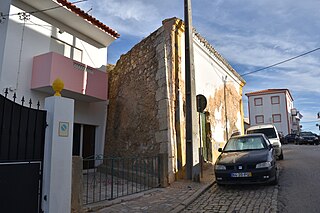
The Castle of Alcantarilha is a medieval fortress and its remnant walls in Portugal, in the civil parish of Alcantarilha, municipality of Silves, in the Portuguese Algarve region of southwestern Iberia. It is a little-known monument, now in ruins, used for the protection of the people of the village and surrounding area from attacks by north African pirates.
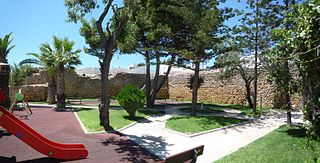
The Castle of Alvor is a medieval castle in the civil parish of Alvor, in the Portuguese district of Faro: considered to be a significant military monument associated with the nearby Castle of Silves.
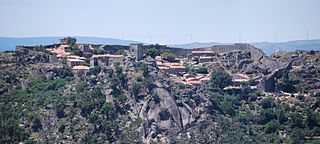
The Castle of Sortelha is a castle in the civil parish of Sortelha in the municipality of Sabugal in the Portuguese Centro region, classified as a National Monument.

The Castle of Alcanede, is a Portuguese medieval castle in civil parish of Alcanede, in the municipality of Santarém, in the Ribatejo district of Santarém.

The Castle of Alfeizerão is a Portuguese medieval castle in civil parish of Alfeizerão, municipality of Alcobaça, and in the Oeste region of the historical Estremadura province.
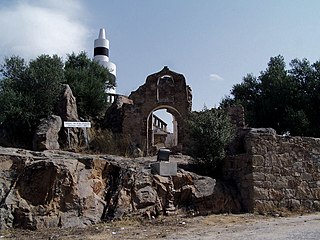
The Castle of Alter do Chão is a Portuguese medieval castle in civil parish of Alter do Chão, in the municipality of Alter do Chão, in the district of Portalegre.
The Castle of Atouguia da Baleia is a medieval castle in the civil parish of Atouguia da Baleia, municipality of Peniche, and in the Oeste region of the historical Estremadura province.
The Castle of Barbacena is a former-medieval castle/fort in the civil parish of Barbacena e Vila Fernando, municipality of Elvas in the Portuguese Alentejo, classified as a Property of Public Interest.

The Castle of Folgosinho, is a medieval castle in the civil parish of Folgosinho, municipality of the Gouveia in the district of Guarda in the Centre region of Portugal.

The Castle of Mirandela is a medieval castle in the civil parish of Mirandela, municipality of the same name, in the Portuguese district of Bragança.

The Castle of Montalvão is a medieval castle in the civil parish of Montalvão, municipality of Nisa, in the Portuguese district of Portalegre.
The Castle of Seda is a medieval castle located in the civil parish of Seda, in the municipality of Alter do Chão, in the Portuguese district of Portalegre.
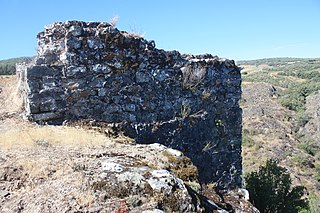
The Castle of Rebordãos is a Portuguese medieval castle in civil parish of Rebordãos, in the municipality of Bragança, in the northern Trás-os-Montes region in district of Bragança. Due to its position on the top of a steep cliff face, the castle was also known as the Castelo de Tourão, or Castle of Polecats, referring to the small mammal indigenous to the region, and known for spotting from stakes, trees or poles. In this case, the title was a metaphor for its position at the top of the high cliff, providing clear visibility to the valley below.

The Castle of Castelo Bom is a medieval castle in the civil parish of Castelo Bom, municipality of the Almeida in the district of Guarda in the Centre region of Portugal.
The Castle of São Ramão is a medieval castle located in the civil parish of Viade de Baixo e Fervidelas, in the municipality of Montalegre, Portuguese district of Vila Real.
The Tower of Bera is the remains of a medieval watchtower located in the civil parish of Almalaguês, in the municipality of Coimbra, Portuguese Coimbra.
References
Notes
- 1 2 3 4 5 6 7 8 9 10 11 12 13 Martin, A. (2016), IGESPAR (ed.), Castelo de Ourique (in Portuguese), Lisbon, Portugal: IGESPAR-Instituto de Gestão do Património Arquitectónico e Arqueológico, retrieved 18 June 2017
- 1 2 3 4 5 6 7 8 9 10 11 12 13 Mendonça, Isabel (1994), SIPA (ed.), Castelo de Ourique (IPA.00000590/PT040212030003) (in Portuguese), Lisbon, Portugal: SIPA – Sistema de Informação para o Património Arquitectónico, retrieved 18 June 2017


